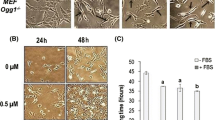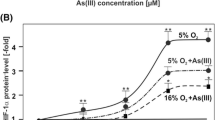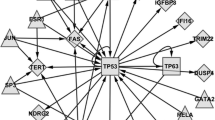Abstract
Chronic exposure to inorganic arsenic is associated with a variety of adverse health effects, including lung, bladder, kidney, and liver cancer. Several mechanisms have been proposed for arsenic-induced tumorigenesis; however, insufficient knowledge and many unanswered questions remain to explain the integrated molecular pathogenesis of arsenic carcinogenicity. In the present study, using non-tumorigenic human liver HepaRG cells, we investigated epigenetic alterations upon prolonged exposure to a noncytotoxic concentration of sodium arsenite (NaAsO2). We demonstrate that continuous exposure of HepaRG cells to 1 µM sodium arsenite (NaAsO2) for 14 days resulted in substantial cytosine DNA demethylation and hypermethylation across the genome, among which the claudin 14 (CLDN14) gene was hypermethylated and the most down-regulated gene. Another important finding was a profound loss of histone H3 lysine 36 (H3K36) trimethylation, which was accompanied by increased damage to genomic DNA and an elevated de novo mutation frequency. These results demonstrate that continuous exposure of HepaRG cells to a noncytotoxic concentration of NaAsO2 results in substantial epigenetic abnormalities accompanied by several carcinogenesis-related events, including induction of epithelial-to-mesenchymal transition, damage to DNA, inhibition of DNA repair genes, and induction of de novo mutations. Importantly, this study highlights the intimate mechanistic link and interplay between two fundamental cancer-associated events, epigenetic and genetic alterations, in arsenic-associated carcinogenesis.




Similar content being viewed by others
References
Anastasiadi D, Esteve-Codina A, Piferrer F (2018) Consistent inverse correlation between DNA methylation of the first intron and gene expression across tissues and species. Epigenet Chromatin 11:37
Andrew AS, Karagas MR, Hamilton JW (2003) Decreased DNA repair gene expression among individuals exposed to arsenic in United States drinking water. Int J Cancer 104:263–268
Argos M (2015) Arsenic exposure and epigenetic alterations: recent findings based on the Illumina 450K DNA methylation array. Curr Envir Health Rpt 2:137–144
Bailey KA, Smith AH, Tokar EJ, Graziano JH, Kim K-W, Navasumrit P, Ruchirawat M, Thiantanawat A, Suk WA, Fry RC (2016) Mechanisms underlying latent disease risk associated with early-life arsenic exposure: current research trends and scientific gaps. Environ Health Perspect 124:170–175
Barajas-Olmos FM, Ortiz-Sáchez E, Imaz-Rosshandler I, Córdova-Alarcón EJ, Martínez-Tovar A, Villanueva-Toledo J, Morales-Martín ME, Cruz-Colín JL, Rangel C, Orozco L, Centeno F (2019) Analysis of the dynamic aberrant landscape of DNA methylation and gene expression during arsenic-induced cell transformation. Gene 711:143941
Baylin SB, Ohm JE (2006) Epigenetic gene silencing in cancer – a mechanism for early oncogenic pathway addiction? Nat Rev Cancer 6:107–116
Benjamini Y, Hochberg Y (1995) Controlling the false discovery rate: a practical and powerful approach to multiple testing. J R Stat Soc Seri B Stat Methodol 57:289–300
Bustaffa E, Stoccoro A, Bianchi F, Migliore L (2014) Genotoxic and epigenetic mechanisms in arsenic carcinogenicity. Arch Toxicol 88:1043–1067
Cao W-Q, Jiang B-Y, Huang J-M, Zhang L, Liu M-Q, Yao J, Wu M-X, Zhang L-J, Kong S-Y, Wang Y, Yang P-Y (2019) Straightforward and highly efficient strategy for hepatocellular carcinoma glycoprotein biomarker discovery using a nonglycopeptide-based mass spectrometry pipeline. Anal Chem 91:12435–12443
Cerec V, Glaise D, Garnier D, Morosan S, Turlin B, Drenou B, Gripon P, Kremsdorf D, Guguen-Guillouzo C, Corlu A (2007) Transdifferentiation of hepatocyte-like cells from the human hepatoma HepaRG cell line through bipotent progenitor. Hepatology 45:957–967
Chang Y-W, Singh KP (2019) Arsenic-induced neoplastic transformation involves epithelial-mesenchymal transition and activation of the β-catenin/c-Myc pathway in human kidney epithelial cells. Chem Res Toxicol 32:1299–1309
Chen H, Li SF, Liu J, Diwan BA, Barrett JC, Waalkes MP (2004) Chronic inorganic arsenic exposure induces hepatic global and individual gene hypomethylation: implications for arsenic hepatocarcinogenesis. Carcinogenesis 25:1779–1786
Dreval K, Tryndyak V, Kindrat I, Twaddle NC, Orisakwe OE, Mudalige TK, Beland FA, Doerge DR, Pogribny IP (2018) Cellular and molecular effects of prolonged low-level sodium arsenite exposure on human hepatic HepaRG cells. Toxicol Sci 162:676–687
Fang J, Huang Y, Mao G, Yang S, Rennert G, Gu L, Li H, Li G-M (2018) Cancer-driving H3G34V/R/D mutations block H3K36 methylation and H3K36me3-MutSα interaction. Proc Natl Acad Sci USA 115:9598–9603
Frediani JF, Naioti EA, Vos MB, Figueroa J, Marsit CJ, Welsh JA (2018) Arsenic exposure and risk of nonalcoholic fatty liver disease (NAFLD) among U.S. adolescents and adults: an association modified by race/ethnicity, NHANES 2005–2014. Environ Health 17:6
Furda A, Santos JH, Meyer JN, Van Houten B (2014) Quantitative PCR-based measurement of nuclear and mitochondrial DNA damage and repair in mammalian cells. Methods Mol Biol 1105:419–437
Higashi Y, Suzuki S, Sakaguchi T, Nakamura T, Baba S, Reinecker H-C, Nakamura S, Konno H (2007) Loss of claudin-1 expression correlates with malignancy of hepatocellular carcinoma. J Surg Res 139:68–76
Hsu L-I, Wang Y-H, Hsieh F-I, Yang T-Y, Jeng RW-J, Liu C-T, Chen C-L, Hsu K-H, Chiou H-Y, Wu M-M, Chen C-J (2016) Effects of arsenic in drinking water on risk of hepatitis or cirrhosis in persons with or without chronic viral hepatitis. Clin Gastroenterol Hepatol 14:1347–1355
Hu DG, Marri S, McKinnon RA, Mackenzie PI, Meech R (2019) Deregulation of the genes that are involved in drug absorption, distribution, metabolism, and excretion in hepatocellular carcinoma. J Pharmacol Exp Ther 368:363–381
Hughes MF, Beck BD, Chen Y, Lewis AS, Thomas DJ (2011) Arsenic exposure and toxicology: a historical perspective. Toxicol Sci 123:305–332
IARC Monographs on the Evaluation of Carcinogenic Risks to Humans (2012) Arsenic, Metals, Fibres, and Dusts, vol 100C. IARC, Lyon
Jia H, Chai X, Li S, Wu D, Fan Z (2019) Identification of claudin-2, -6, -11 and -14 as prognostic markers in human breast carcinoma. Int J Clin Exp Pathol 12:2195–2204
Jiang R, Li Y, Xu Y, Zhou Y, Pang Y, Shen L, Zhao Y, Zhang J, Zhou J, Wang X, Liu Q (2013) EMT and CSC-like properties mediated by the IKKβ/IκBα/RelA signal pathway via the transcriptional regulator, Snail, are involved in the arsenite-induced neoplastic transformation of human keratinocytes. Arch Toxicol 87:991–1000
Kanu N, Grönroos E, Martinez P, Burrell RA, Yi Goh H, Bartkova J, Maya-Mendoza A, Mistrík M, Rowan AJ, Patel H, Rabinowitz A, East P, Wilson G, Santos CR, McGranahan N, Gulati S, Gerlinger M, Birkbak NJ, Joshi T, Alexandrov LB, Stratton MR, Powles T, Matthews N, Bates PA, Stewart A, Szallazi Z, Larkin J, Bartek J, Swanton C (2015) SETD2 loss-of-function promotes renal cancer branched evolution through replication stress and impaired DNA repair. Oncogene 34:5699–5708
Knights AJ, Funnell APW, Crossley M, Pearson RCM (2012) Holding tight: cell junctions and cancer spread. Trends Cancer Res 8:61–69
Koboldt DC, Zhang Q, Larson DE, Shen D, McLellan MD, Lin L, Miller CA, Mardis ER, Ding L, Wilson RK (2012) VarScan 2: somatic mutation and copy number alteration discovery in cancer by exome sequencing. Genome Res 22:568–576
Kojima T, Takano K-i, Yamamoto T, Murata M, Son S, Imamura M, Yamaguchi H, Osanai M, Chiba H, Himi T, Sawada N (2008) Transforming growth factor-β induces epithelial to mesenchymal transition by down-regulation of claudin-1 expression and the fence function in adult rat hepatocytes. Liver Int 28:534–545
Lehle S, Hildebrandt DG, Merz B, Malak PN, Becker MS, Schmezer P, Essmann F, Schulze-Osthoff K, Rothfuss O (2014) LORD-Q: a long-run real-time PCR-based DNA-damage quantification method for nuclear and mitochondrial genome analysis. Nucleic Acids Res 42:e41
Li F, Mao G, Tong D, Huang J, Gu L, Yang W, Li G-M (2013) The histone mark H3K36me3 regulates human DNA mismatch repair through its interaction with MutSα. Cell 153:590–600
Li C-P, Cai M-Y, Jiang L-J, Mai S-J, Chen J-W, Wang F-W, Liao Y-J, Chen W-H, ** X-H, Pei X-Q, Guan X-Y, Zeng M-S, **e D (2016) CLDN14 is epigenetically silenced by EZH2-mediated H3K27ME3 and is a novel prognostic biomarker in hepatocellular carcinoma. Carcinogenesis 37:557–566
Liu X, Ling M, Chen C, Luo F, Yang P, Wang D, Chen X, Xu H, Xue J, Yang Q, Lu L, Lu J, Bian Q, Zhang A, Liu Q (2017) Impaired autophagic flux and p62-mediated EMT are involved in arsenite-induced transformation of L-02 cells. Toxicol Appl Pharmacol 334:75–87
Li J, Ahn JH, Wang GG (2019) Understanding histone H3 lysine 36 methylation and its deregulation in disease. Cell Mol Life Sci 76:2899–2916
Li L, Wang Y (2017) Cross-talk between the H3K36me3 and H4K16ac histone epigenetic marks in DNA double-strand break repair. J Biol Chem 292:11951–11959
Liu J, Waalkes MP (2008) Liver is a target of arsenic carcinogenesis. Toxicol Sci 105:24–32
Mas VR, Maluf DG, Archer KJ, Yanek K, Bornstein K, Fisher RA (2009) Proteomic analysis of HCV cirrhosis and HCV-induced HCC: identifying biomarkers for monitoring HCV-cirrhotic patients awaiting liver transplantation. Transplantation 87:143–152
Michalidi C, Hayashi M, Datta S, Sen T, Zenner K, Oladeru O, Brait M, Izumchenko E, Baras A, VandenBussche C, Argos M, Bivalacqua TJ, Ahsan H, Hahn NM, Netto GJ, Sidransky D, Hoque MO (2015) Involvement of epigenetics and EMT-related miRNA in arsenic-induced neoplastic transformation and their potential clinical use. Cancer Prev Res (Phila) 8:208–221
Niu B, Ye K, Zhang Q, Lu C, **e M, McLellan MD, Wendl MC, Ding L (2014) MSIsensor: microsatellite instability detection using paired tumor-normal sequence data. Bioinformatics 30:1015–1016
Osanai M, Takasawa A, Murata M, Sawada N (2017) Claudins in cancer: bench to bedside. Pflug Arch 469:55–67
Pascale RM, De Miglio MR, Muroni MR, Simile MM, Daino L, Seddaiu MA, Pusceddu S, Gaspa L, Calvisi D, Manenti G, Feo F (1998) Transferrin and transferrin receptor gene expression and iron uptake in hepatocellular carcinoma in the rat. Hepatology 27:452–461
Pfister SX, Ahrabi S, Zalmas L-P, Sarkar S, Aymard F, Bachrati CZ, Helleday T, Legube G, La Thangue NB, Porter ACG, Humphrey TC (2014) SETD2-dependent histone H3K36 trimethylation is required for homologous recombination repair and genome stability. Cell Rep 7:2006–2018
Ren X, McHale CM, Skibola CF, Smith AH, Smith MT, Zhang L (2011) An emerging role of epigenetic dysregulation in arsenic toxicity and carcinogenesis. Environ Health Perspect 119:11–19
Schmittgen TD, Livak KJ (2008) Analyzing real-time PCR data by the comparative CT method. Nat Protoc 3:1101–1108
Schmutte C, Jones PA (1998) Involvement of DNA methylation in human carcinogenesis. Biol Chem 379:377–388
Souady J, Hülsewig M, Distler U, Haier J, Denz A, Pilarsky C, Senninger N, Dreisewerd K, Peter-Katalinić J, Müthing J (2011) Differences in CD75s- and iso-CD75s-ganglioside content and altered mRNA expression of sialyltransferases ST6GAL1 and ST3GAL6 in human hepatocellular carcinomas and nontumoral liver tissues. Glycobiology 21:584–594
Tam LM, Price NE, Wang Y (2020) Molecular mechanisms of arsenic-induced disruption of DNA repair. Chem Res Toxicol 33:709–726
The 1000 Genomes Project Consortium (2015) A global reference for human genetic variation. Nature 526:68–74
Tong D, Ortega J, Kim C, Huang J, Gu L, Li G-M (2015) Arsenic inhibits DNA mismatch repair by promoting EGFR expression and PCNA phosphorylation. J Biol Chem 290:14536–14541
Tryndyak VP, Beland FA, Pogribny IP (2010) E-cadherin transcriptional down-regulation by epigenetic and microRNA-200 family alterations is related to mesenchymal and drug-resistant phenotypes in human breast cancer cells. Int J Cancer 126:2575–2583
Tryndyak V, Han T, Fuscoe JC, Ross SA, Beland FA, Pogribny IP (2016) Status of hepatic DNA methylome predetermines and modulates the severity of non-alcoholic fatty liver injury in mice. BMC Genom 17:298
Tryndyak V, Kindrat I, Dreval K, Churchwell MI, Beland FA, Pogribny IP (2018) Effect of aflatoxin B1, benzo[a]pyrene, and methapyrilene on transcriptomic and epigenetic alterations in human liver HepaRG cells. Food Chem Toxicol 121:214–223
Tsukita S, Tanaka H, Tamura A (2019) The claudins: from tight junctions to biological systems. Trends Biochem Sci 44:141–152
Wang W, Cheng S, Zhang D (2014) Association of inorganic arsenic exposure with liver cancer mortality: a meta-analysis. Environ Res 135:120–125
Weinmuellner R, Kryeziu K, Zbiral B, Tav K, Schoenhacker-Alte B, Groza D, Wimmer L, Schosserer M, Nagelreiter F, Rösinger S, Mildner M, Tschachler E, Grusch M, Grillari J, Heffeter P (2018) Long-term exposure of immortalized keratinocytes to arsenic induces EMT, impairs differentiation in organotypic skin models and mimics aspects of human skin derangements. Arch Toxicol 92:181–194
van Wenum M, Treskes P, Tang C-Y, Coppens EJ, Jansen K, Hendriks EJ, Camus S, van Gulik TM, Chamuleau RAFM, Hoekstra R (2017) Scaling-up of a HepaRG progenitor cell based bioartificial liver: optimization for clinical application and transport. Biofabrication 9:035001
Yorifuji T, Tsuda T, Doi H, Grandjean P (2011) Cancer excess after arsenic exposure from contaminated milk powder. Environ Health Prev Med 16:164–170
Zhou Q, ** S (2018) A review on arsenic carcinogenesis: epidemiology, metabolism, genotoxicity and epigenetic changes. Regul Toxicol Pharmacol 99:78–88
Acknowledgements
This work was partly supported by appointment of B. Borowa-Mazgaj to the Postgraduate Research Program and C.R. Steward to the Summer Student Research Program at the National Center for Toxicological Research administered by the Oak Ridge Institute for Science and Education. The views expressed in this manuscript do not necessarily represent those of the U.S. Food and Drug Administration.
Author information
Authors and Affiliations
Corresponding author
Ethics declarations
Conflict of interest
The authors declare that they have no conflict of interest.
Additional information
Publisher's Note
Springer Nature remains neutral with regard to jurisdictional claims in published maps and institutional affiliations.
Electronic supplementary material
Below is the link to the electronic supplementary material.
Rights and permissions
About this article
Cite this article
Tryndyak, V.P., Borowa-Mazgaj, B., Steward, C.R. et al. Epigenetic effects of low-level sodium arsenite exposure on human liver HepaRG cells. Arch Toxicol 94, 3993–4005 (2020). https://doi.org/10.1007/s00204-020-02872-6
Received:
Accepted:
Published:
Issue Date:
DOI: https://doi.org/10.1007/s00204-020-02872-6




